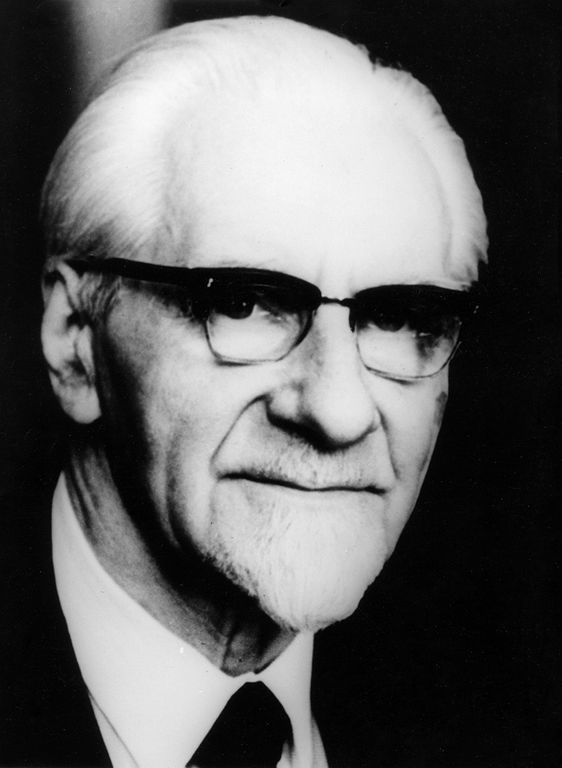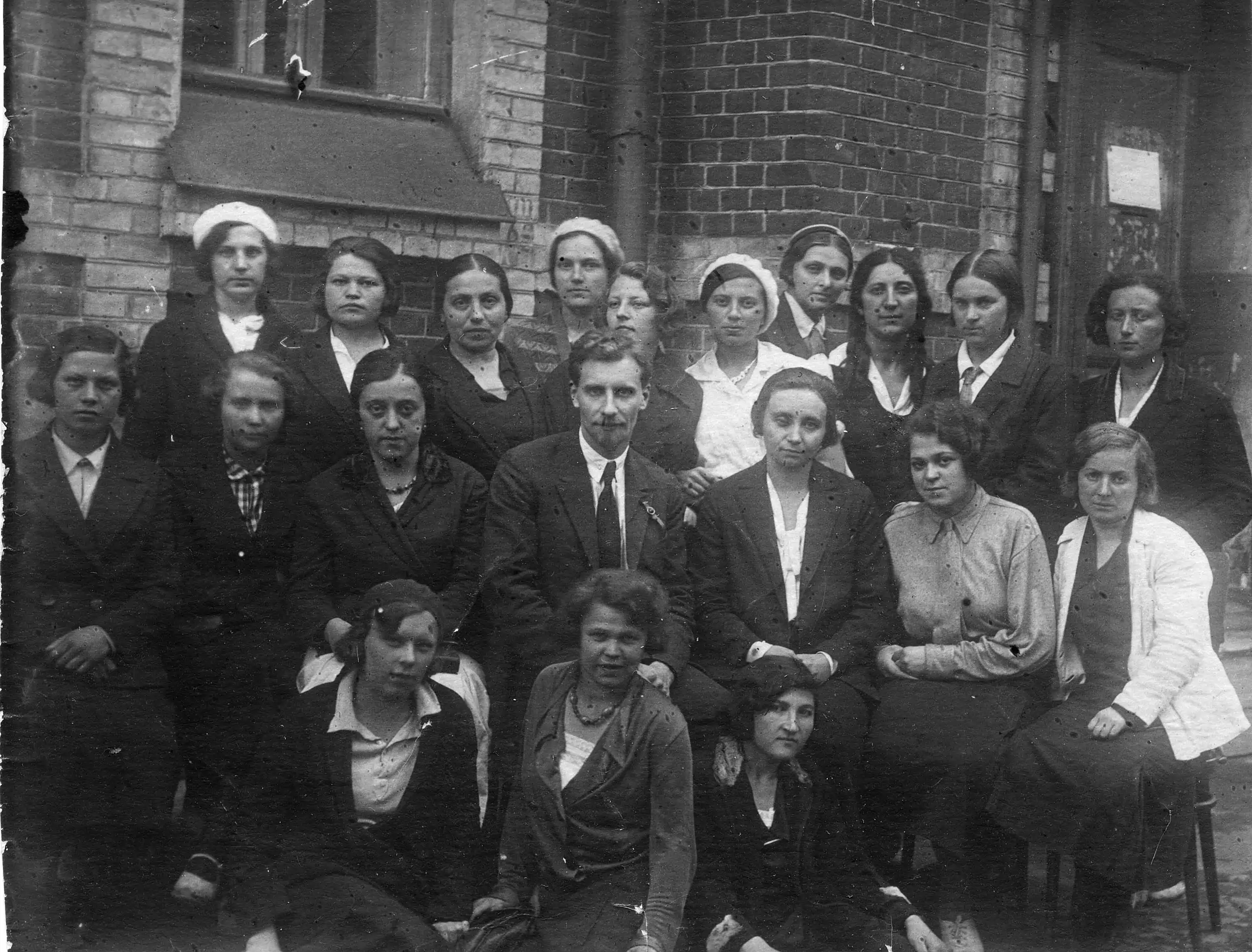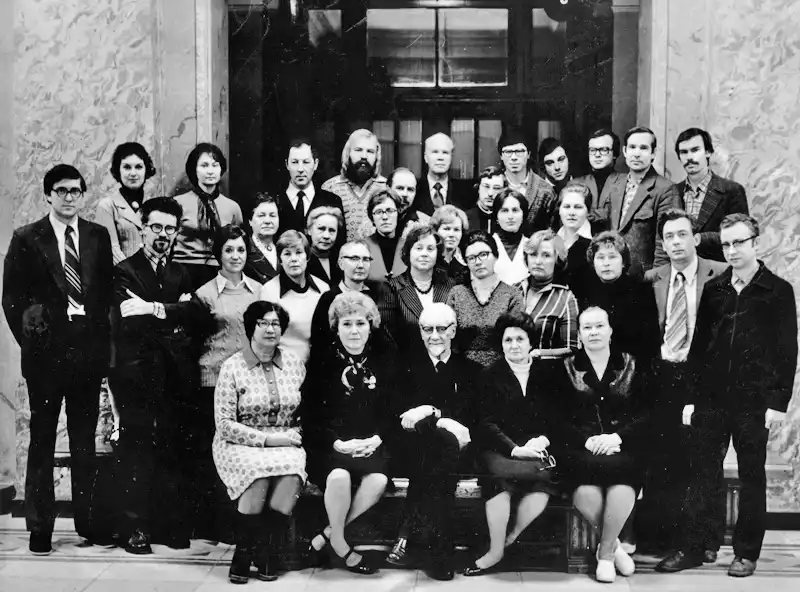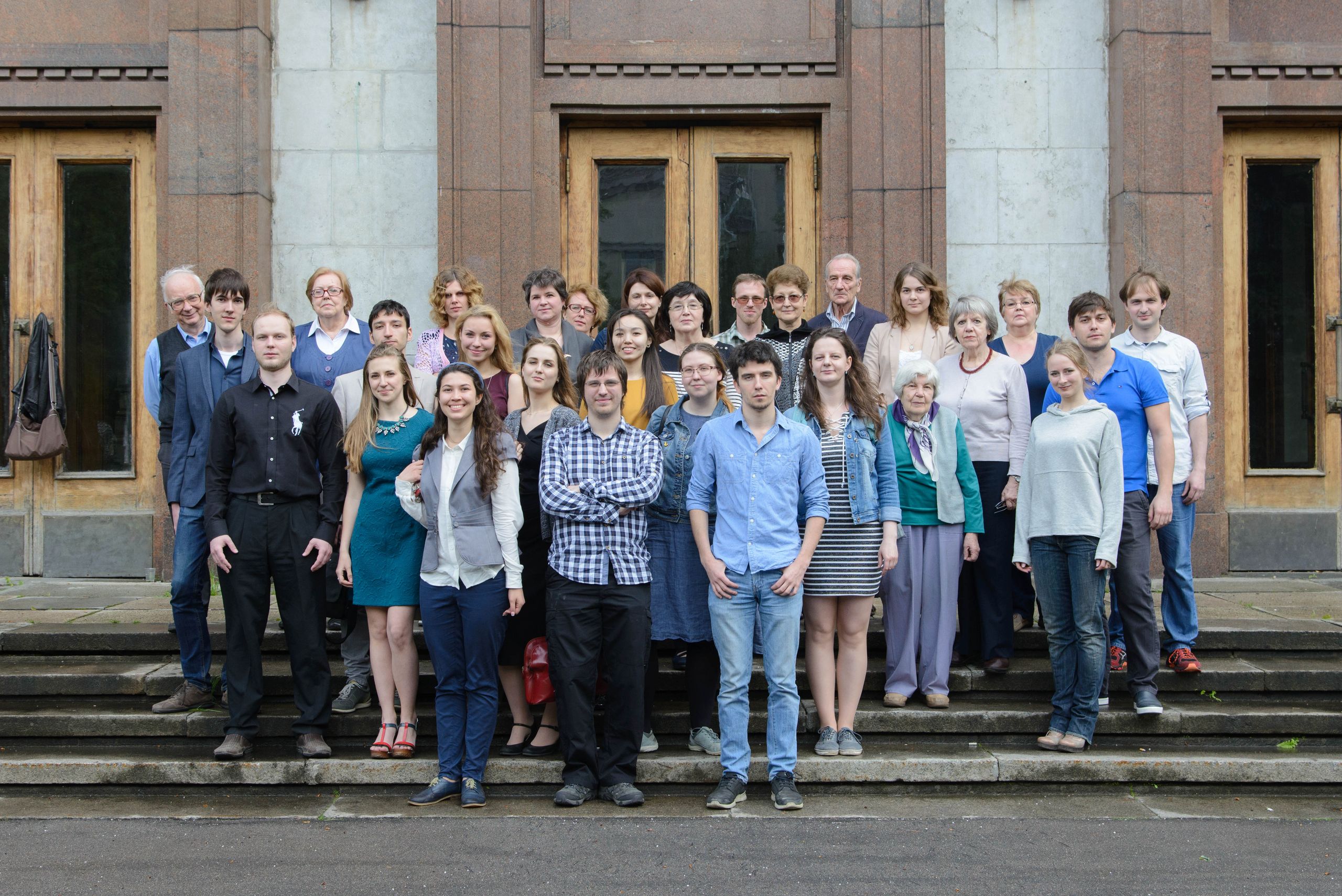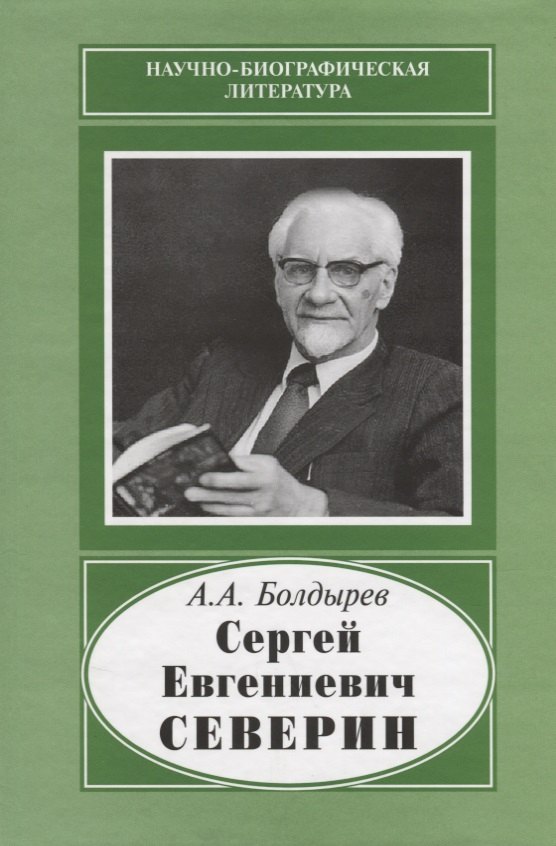История кафедры
К 80-летнему юбилею кафедры биохимии ее коллектив подготовил буклет, описывающий основные этапы становления кафедры, достижения научных групп и воспоминания выпускников разных лет. В издании приняли участие многие сотрудники, которые собирали исторические факты, подготавливали иллюстрации, редактировали тексты и стремились отразить долгую и славную историю кафедры.
Основание кафедры
Исторически первая кафедра биохимии (точнее кафедра медицинской химии) была организована на медицинском факультете Московского Университета в 1863 году. С 1863 по 1907 год этой кафедрой руководил Александр Дмитриевич Булыгинский. В 1901 году на кафедру медицинской химии в качестве экстраординарного профессора был приглашен Владимир Сергеевич Гулевич, который в 1907 году возглавил эту кафедру. В первые годы ХХ века В.С. Гулевич провел ставшие классическими исследования, посвященные азотсодержащим экстрактивным соединениям мышечной ткани. Им были открыты гистидин-содержащие дипептиды (карнозин и анзерин), а также новое азотсодержащее соединение – карнитин. Оказалось, что карнитин обеспечивает транспорт жирных кислот в митохондрии и таким образом играет исключительно важную роль в обеспечении клетки энергией. В.С. Гулевич был не только выдающимся ученым (в 1929 году он был избран действительным членом академии наук СССР), но и замечательным педагогом. Одним из самых ярких учеников В.С. Гулевича был Сергей Евгеньевич Северин, ставший организатором кафедры биохимии на биологическом факультете Московского государственного университета.
В 1930 году произошло выделение из Московского Университета медицинских институтов со всеми принадлежащими им кафедрами и лабораториями, и практически одновременно с этим в системе Московского Университета был создан биологический факультет. Возникла необходимость создания на новом факультете кафедр биохимической направленности. Первой такой кафедрой стала кафедра биохимии растений, созданная в 1929 году Александром Робертовичем Кизелем. Параллельно с этим на биологическом факультете стала работать кафедра физиологии животных и человека, изначально организованная в 1924 году А.Ф. Самойловым на медицинском факультете МГУ и осуществлявшая преподавание физиологии студентам естественного отделения физико-математического факультета.
С 1930 года эту кафедру на биологическом факультете возглавил Иосиф Львович Кан. На кафедре физиологии было создано несколько отделений, которыми руководили такие выдающиеся ученые, как И.П. Разенков, А.Н. Магницкий и Х.С. Коштоянц.
На биохимическом отделении кафедры физиологии с 1929 стал работать С.Е.Северин, которому было поручено создание нового раздела большого практикума, посвященного изучению биохимии крови, и чтение курса лекций по биохимии. Помощником С.Е.Северина стала А.В. Голубцова. В 1935 году С.Е. Северин возглавил созданную на биологическом факультете МГУ лабораторию биохимии животных. В связи с бурным развитием биохимии в 1939 году было решено создать на биологическом факультете МГУ самостоятельную кафедру биохимии животных (с 1973 года — кафедра биохимии). Заведующим кафедрой был избран Сергей Евгеньевич Северин, а вторым профессором стал Владимир Александрович Энгельгардт. Новой кафедре было выделено четыре комнаты в старом здании университета, в которых после перепланировки и ремонта стали работать первые сотрудники кафедры: А.В. Голубцова, Н.П. Мешкова, К.Ф. Сорвачев и С.Е. Северин.
Кафедра
в 40е — 50е годы
В 1940 г. состоялся первый выпуск кафедры биохимии. Среди выпускников того года были ставшая впоследствии профессором Г.В. Андреенко, на протяжении многих лет успешно работавшая в области гемостаза, и ставший впоследствии действительным членом АМН СССР Н.А. Юдаев, внесший большой вклад в отечественную эндокринологию. Успешно начавшаяся научная и педагогическая деятельность кафедры была прервана Великой Отечественной войной. Кафедра вернулась из эвакуации в Москву в 1943 году. В 1954 году было построено новое здание Московского Государственного Университета на Ленинских горах, и кафедра биохимии, к тому времени заметно расширившаяся, получила новые помещения.
В это время на кафедре работали член-корреспондент АН СССР, академик АМН, профессор С.Е. Северин, академик АН СССР, профессор В.А. Энгельгардт, доценты А.В. Голубцова, Н.В. Алексахина и К.Ф. Сорвачев. Доцент (впоследствии профессор) Н.П. Мешкова стояла у истоков создания большого практикума и на протяжении многих лет была организатором всего учебного процесса на кафедре. В это же время на кафедре работали ассистент М.К. Миловидова, научные сотрудники А.А. Диканова, П.Л. Вульфсон, В.И. Телепнева, Е.А. Мишукова, И.М. Бочарникова, а также многочисленные аспиранты и технический персонал. Следует вспомнить преданных делу хозяйственных лаборантов С.Н. Горохову, Е.П. Унтилову, а в последующие годы М.И. Якунину и инженера А.Н. Бессонова. Традиции организации работы на практикумах вместе с преподавателями были заложены лаборантами Н.В. Шорниковой, О.Е. Карявкиной и А.Ф. Татариновой. Переезд в новое здание создал предпосылки для роста. Вскоре на кафедре биохимии стали работать доцент Е.И. Королева, другие молодые сотрудники и преподаватели, вчерашние выпускники университета. Среди них были Н.К. Наградова, Г.А. Кочетов, В.П. Скулачев, Н.Н. Зайцева, М.И. Сафронова, Г.А. Соловьева, В.С. Гомазкова, а через некоторое время А.Д. Виноградов, Е.В. Петушкова, Ю.Н. Лейкин, Л.К. Сколышева, Т.Ю. Липская, М.М. Фейгина, Н.Ю. Гончарова, Л.В. Белоусова, А.А. Болдырев и многие другие. Многие из сотрудников, стоявших у истоков создания кафедры (профессор Н.К. Наградова, доцент М.И. Сафронова), а также заслуженные преподаватели МГУ Г.А. Соловьева и Н.Н. Зайцева, до последнего времени работали на кафедре биохимии. Они старались сохранить и донести до молодого поколения традиции, сложившиеся за более чем 80-летнию историю кафедры и, даже уйдя на пенсию, живо интересуются последними событиями, происходящими на кафедре.
В 1959 году по инициативе академика Сергея Евгеньевича Северина на Биолого-почвенном факультете при кафедре биохимии животных была организована лаборатория изотопного анализа. Её возглавил доцент кафедры биохимии Константин Федорович СОРВАЧЕВ, который одним из первых стал применять меченые радиоактивными изотопами соединения в исследовании биохимических процессов, в частности, в изучении метаболизма 35S- и 14C-меченых аминокислот у рыб. Позже лаборатория превратилась в общефакультетское подразделение. В начале 70-ых лаборатория была практически полностью переоснащена — появились передовые по тем временам автоматизированные жидкостные сцинтилляционные счетчики Марк-2 фирмы “Nuclear Chicago” (США-Голландия), которые долгое время широко использовались многочисленными сотрудниками разных кафедр биологического факультета.
1960е-70е годы
В начале 60-х годов по инициативе академика Андрея Николаевича Белозерского и активной помощи ректора МГУ академика И.Г. Петровского началось создание новой межфакультетской лаборатории биоорганической химии. Внутри этого научного института были организованы отдельные лаборатории и отделы, одним из которых стал отдел биохимии животной клетки, который возглавил С.Е. Северин. В этом отделе стали работать и проводить успешные исследования в области энзимологии многие бывшие выпускники и сотрудники кафедры биохимии (Н.К. Наградова, Г.А. Кочетов, Л.С. Хайлова, В.С. Гомазкова, П.П. Филиппов, В.И. Муронец, Н.Н. Чернов, Р.А. Асриянц, Л.Е. Мешалкина и многие другие). Этот отдел стал в определенном смысле филиалом кафедры биохимии и поэтому многие студенты выполняли и выполняют свои дипломные и курсовые работы в Межфакультетской лаборатории. Помимо отдела животной клетки в Межфакультетской лаборатории биоорганической химии был создан отдел биоэнергетики, который возглавил бывший выпускник кафедры биохимии академик РАН Владимир Петрович Скулачев. Сотрудники этого отдела активно участвуют в педагогическом процессе и руководят дипломными и курсовыми работами студентов кафедры биохимии. В 1972 году после смерти А.Н. Белозерского работу института, переименованного в Научно-исследовательский институт физико-химической биологии имени А.Н. Белозерского, возглавил академик В.П. Скулачев. Отдел животной клетки вместо академика С.Е. Северина возглавил сначала профессор Г.А. Кочетов, а затем выпускник кафедры биохимии профессор В.И. Муронец. Был создан новый отдел сигнальных систем клетки во главе с бывшим выпускником кафедры биохимии профессором П.П. Филиповым. Все эти административные изменения не только не помешали, но, наоборот, способствовали улучшению и углублению контактов между НИИ физико-химической биологии и кафедрой биохимии биологического факультета МГУ.
В конце 60-х – начале 70-х годов на кафедре биохимии стали интенсивно развиваться исследования, посвященные изучению молекулярных механизмов передачи гормонального сигнала, и в частности исследованию аденилат- и гуанилатциклаз, растворимых и мембрансвязанных G-белков, фосфодиэстераз и различных протеинкиназ. В 1977 году по инициативе С.Е. Северина и при активном участии Е.С. Северина, В.А. Ткачука и Т.В. Буларгиной при кафедре биохимии была создана Проблемная лаборатория химии ферментов. Сотрудниками этой лаборатории была изучена структура активного центра сАМР-зависимой протеинкиназы (С.П. Петухов), исследованы различные изоформы фосфодиэстеразы циклических нуклеотидов (И.Д. Бобрускин), участие G-белков в передаче гормонального сигнала (В.А. Ткачук, А.В Скурат, К.М. Попов, А.Я. Коц), синтезированы новые аналоги нуклеотидов (Н.Н. Гуляев, Ю.В. Хропов). Исследования в этом направлении зачастую целиком опирались на применении метода меченых атомов и проводились в лаборатории изотопного анализа. В это время лаборатория работала очень интенсивно, а сотрудники лаборатории обеспечивали бесперебойную работу всего сложного оборудования (инженеры П.Ю. Пастушенко, Т.Л. Бочарникова, А.А. Розенкранц – в разные годы) и разработку новых эффективных методов регистрации изотопов (ст. науч. сотр. Р.Д. Озрина). С появлением в лаборатории жидкостных сцинтилляционных α- и γ-счетчиков расширился и модернизировался практикум для студентов 2-, 3- и 4-го курсов биологического факультета по основам и применению радиоиндикаторного метода в биологических исследованиях. Первые задачи для практикума были разработаны доцентами Л.Г. Ягловой, Г.В. Коссовой и ассистентом Э.С. Имашевой.
1980е — 90е годы
В 80-х годах было начато исследование NO-синтазы (А.Я. Коц) и проведены оригинальные исследования взаимодействия кальмодулина с различными внутриклеточными белками (В.А. Ткачук, М.Ю. Меньшиков). В Проблемной лаборатории химии ферментов получило активно развитие новое научное направление, связанное с получением моноклональных антител и использованием разнообразных иммунохимических методов в медицинской практике (Т.В. Буларгина, А.В. Березникова, А.Г. Катруха). В связи с различными административными перестановками Проблемная лаборатория химии ферментов на какое-то время переходила на кафедру биоорганическй химии. Однако сотрудники лаборатории продолжали активно работать и сотрудничать с кафедрой биохимии и активно участвовали в педагогическом процессе. В 2019 году Проблемная лаборатория химии ферментов вернулась на кафедру биохимии.
На протяжении многих лет основным направлением исследований на кафедре биохимии является изучение структуры, свойств и механизма функционирования различных белков и ферментов. В различное время на кафедре работали и/или работают научные группы, успешно исследовавшие проблемы окислительного фосфорилирования (В.П. Скулачев, А.Д. Виноградов), физиологическую роль и механизм функционирования низкомолекулярных азотсодержащих экстрактивных соединений (Н.П. Мешкова, Е.И. Королева, А.А. Болдырев), разнообразные ферменты гликолиза и пентозофосфатного пути (Н.К. Наградова, Г.А. Кочетов, В.И. Муронец), ферменты, участвующие в превращении гликогена (П.Л. Вульфсон, Г.А. Соловьева), дегидрогеназы α-кетокислот (В.С. Гомазкова, Л.С. Хайлова, М.М. Фейгина), ферменты, участвующие в синтезе и утилизации АТФ (Т.Ю. Липская, Л.В. Белоусова, Н.Ю. Гончарова), мембранные транспортные АТРазы (А.А. Болдырев, В.А. Ткачук, О.Д. Лопина, А.М. Рубцов), а также сократительные и регуляторные белки мышц (И.М. Бочарникова, Е.В. Петушкова, Н.Б. Гусев). Подробно научная тематика исследовательских групп, работающих на кафедре в настоящее время, описана на соответствующих страницах буклета.
Произошли существенные улучшения в лаборатории изотопного анализа. По мере появления в лаборатории новой аппаратуры совершенствовался педагогический процесс. Руководитель студенческого практикума, доцент Н. В. Алексеева, разработала и ввела целый ряд новых задач, отвечающих современным методам изотопных исследований. Был запущен и введен в строй авторадиографический сканер «Шторм», предназначенной для качественного и количественного определения β- и γ- излучателей, а также новый современный жидкостной сцинтилляционный анализатор Tri-Carb 4810 TR (PerkinElmer, США). В 2012 г. в лаборатории изотопного анализа появился уникальный прибор — однофотонный эмиссионный компьютерный томограф U-SPECT-II/CT для регистрации и количественного измерения включения радиоактивной метки в организм мелких лабораторных животных in vivo. Это позволило превратить лабораторию в образцово-показательную научно-учебную площадку по трехмерному высокоточному количественному исследованию распределения введенных меченых соединений в организме лабораторных животных. В 1971 г. заведующей лабораторией изотопного анализа стала доцент Л. Г. Яглова, а лаборатория стала частью кафедры физико-химической биологии. В 1989 г., заведывание лабораторией было возложено на старшего научного сотрудника Раду Драгановну Озрину, которая руководит лабораторией по настоящее время, с 2013 года лаборатория стала подразделением кафедры биохимии
Долгие годы педагогическая работа кафедры зиждилась на самоотверженной работе преподавателей старшего поколения, бывших выпускников кафедры: Н.Н. Зайцевой, Г.А. Соловьевой, М.И. Сафроновой, Н.Ю. Гончаровой, Л.В. Белоусовой, О.Е. Карявкиной. Представители старшего поколения выпускников кафедры были создателями новых направлений исследований. Так научные группы, созданные Н.К. Наградовой и Г.А. Кочетовым, до сих пор продолжают успешные исследования в области энзимологии. Научная группа, созданная А.А. Болдыревым, выполнила обширные исследования природных дипептидов, а также исследовала молекулярные механизмы окислительного стресса и защиты клетки от различных неблагоприятных воздействий.
2000-е годы
Нынешнее поколение сотрудников кафедры старается сохранять старые традиции и развивать новые направления исследований. Сейчас штатными преподавателями кафедры являются профессора А.Д. Виноградов, Н.Б. Гусев, А.Г. Катруха, В.И. Муронец, А.М. Рубцов и В.П. Скулачев. . Помимо этого, на кафедре работают 8 доцентов, 2 старших преподавателя и 2 ассистента, работу которых поддерживают несколько человек обслуживающего персонала. Научный штат кафедры состоит из 17 человек, включая четырех ведущих научных сотрудников, 4 старших научных сотрудников, 4 научных сотрудников, 5 младших научных сотрудников, а также обслуживающий персонал.
Академик С.Е. Северин, на протяжении более 50-лет возглавлявший кафедру биохимии, был создателем большой школы отечественных биохимиков. Сейчас трудно найти научно-исследовательскую лабораторию, где бы ни работали бывшие выпускники кафедры. За время существования с 1939 года кафедра биохимии подготовила более 1200 специалистов-биохимиков широкого профиля. Кафедра может по праву гордиться своими выпускниками, ставшими ведущими биохимиками в нашей стране и получившими мировое признание. Среди них академики РАН Л.Л. Киселев, В.П. Скулачев, С.В. Шестаков, В.А. Гвоздев, В.А. Ткачук, член-корреспондент РАН Б.Ф. Поглазов, академики РАМН Ю.А. Владимиров, Н.А. Юдаев и многие другие.
Отмечая выдающиеся заслуги С.Е. Северина и его вклад в развитие отечественной науки и создание школы биохимиков, с 1999 года проводились ежегодные научные чтения, во время которых студентам старших курсов, специализирующимся в области физико-химической биологии и достигших особых успехов в учебе и научной деятельности, вручались стипендии имени С.Е. Северина. По инициативе профессора кафедры биохимии А.Г. Катрухи с 2020 года начал проводиться Студенческий биохимический форум, пользующийся большой популярностью. С пленарными докладами на этом форуме выступают выдающиеся отечественные ученые, а на заседаниях секций и на стендовой сессии выступают бакалавры, магистранты и аспиранты, работающие в области физико-химической биологии и приезжающие из разных городов Российской федерации и ближнего зарубежья.
